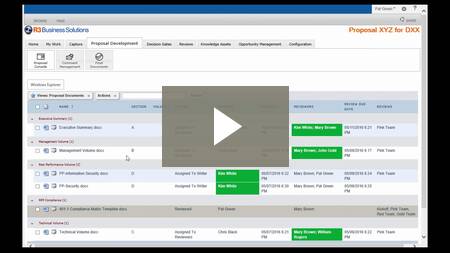It’s a fundamental question in proposal development. Every document or section in a proposal goes through a lifecycle of being worked on by writers, ad hoc reviewers, and formal team reviews. At any time some person or persons “has the ball” and is doing their work. So, we start with a simple question – “Who’s got the ball?”.
Talented, organized, very hard working proposal managers with trusted, trained participants can reasonably answer this question. The problem is the level of skill, attention to detail and effort that it takes to stay on top of the work in order to be able to answer it. And, as I’ll describe below, in most cases the reality is that you don’t truly know.
The situation is that most proposal organizations use document storage systems for proposal development. They have a library or folder storing many documents. While they may assign documents/sections to people, there is no practical way to control who can do what, to which document, at any given time. If 20 people have access to the library or folder, then, 20 things could be happening. So, while you think you know who is working on something, you can’t be sure.
The question “Who’s got the ball?” just highlights a symptom of the core problem. In reality, most organizations don’t have a system that helps them manage and control the work. They just have a system to store documents. The result is that it takes a great deal of manual work to get the job done.
Let’s look at how proposal development managers work to try and stay on top of things:
- They use email to make work assignments, usually attaching documents, and trusting that the right people are working on the right documents at the right time.
- They track documents and assignments and status in a spreadsheet.
- They have status update meetings to find out what is actually going on.
- They check email for status updates.
- They use email to send and receive documents and then manually manage versions.
- They collate information and comments manually.
- They have more calls, emails, and meetings to communicate the situation.
Throughout the proposal development work cycle most of this work is done manually. There is little real-time visibility into where things stand. There is little real-time collaboration. And, fundamentally there still is no real control over “Who’s got the ball?”.
In the Spring ‘16 release of R3 WinCenter, we’ve attacked this challenge. With a bit of innovation, we’ve streamlined, automated and brought the process of managing proposal development work under control. Now, you can know exactly “Who’s got the ball””?”. So, when the right people are doing their work, others don’t have access to documents. It is up to you to flip the switch. Simple and easy.
And, in the process just about all of the other manual tasks described above just go away. Poof! Suddenly, the proposal development manager gets back half of their time each day (50%). The work is brought under control. They can now focus their attention on the quality of the product instead of being distracted by the manual, administrative activity. The work is made easier for all participants and supported by real-time collaboration.
To fully appreciate how wonderful work can be, it really helps to experience it. So, below we have a short 4 minute “day-in-the-life” styled video. It will walk you through the flow of how a proposal manager can drive proposal development work and manage the ping-pong of the ball between writers and ad hoc reviewers. You’ll get a sense for how streamlined and automated the work is. And, of course you’ll see how at any time they can see and control “Who’s got the ball?”.
For additional information and day-in-the-life videos for proposal development work see WinCenter Proposal Management.


